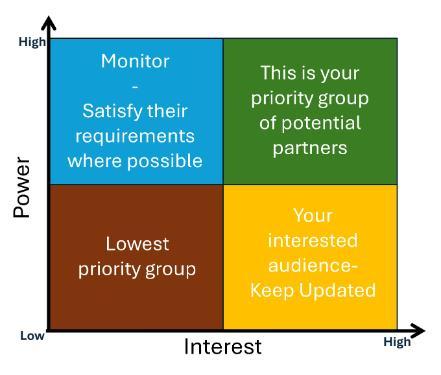Active collaboration and partnership is the cornerstone of engaged research. This section will help you understand how to identify and connect with external partners.
1. Identify

| Consider these questions to help you identify partners |
| Who has knowledge that can help you understand the context of your research? |
| Who has knowledge that can help you understand realities of proposed solutions? |
| Who will be implementing the outputs/outcomes in practice? |
| Who will be impacted by the research? |
| Who can prevent the implementation of research findings? |
| Who can promote implementation of research findings? |
Remember, the people researchers collaborate with have an affiliation to the research. This affiliation can vary but may include:
- Geographical proximity (e.g. local community impacted by research)
- Special interest (e.g. amateur environmental groups)
- Lived experience (e.g. people living with a specific health condition),
- Community based organisations (e.g. local development partnerships)
- Community institutions (e.g. Schools)
- Non governmental organisations (e.g. charities focused on the research topic)
2. Analyse Stakeholders
Once you have identified your list of potential stakeholders, it is important to prioritise them based on the needs of the research and the gaps in knowledge or influence of the research team.
There are many ways to carry out stakeholder analysis, but the Power/Influence grid is one of the most common methods.
Power: Power to affect your research
Interest: Share similar concerns to your research subject
 |
Plot each stakeholder on the grid. To do this, consider the stakeholder’s:
These can be either positive or negative. Those stakeholders plotted on the upper right quadrant represent your pool of stakeholders to consider for partnership or collaboration. |
3. Plan and design engagement
When planning engagement with partners, remember who you work with and their level of involvement over the course of the research lifecycle may vary. There is no one size fits all approach and planning should be done in collaboration with your partners.
Good engagement planning can be enabled by:
- Defined stakeholder expectations
- Robust communication plan
- Transparent and iterative monitoring & evaluation
- Adequate Budget
Designing the engagement plan can be greatly enabled by co-design or at a minimum, having some understanding of the needs of your stakeholders.
| Physical environment |
Language |
Local needs |
| Technological environment |
Access |
Local priorities |
| Attitudinal environment |
Literacy | Trust |
| Previous experience of community |
Culture | Assumptions |